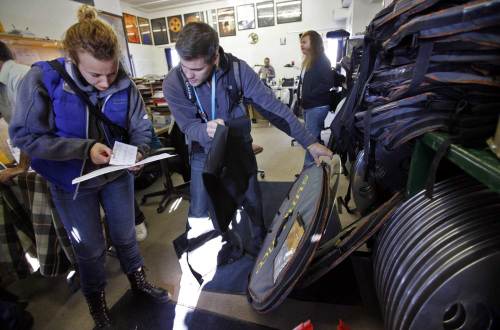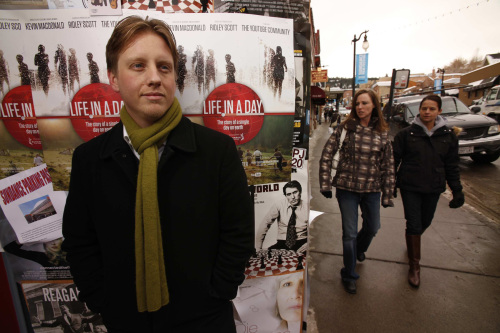Tired eyes of festival gatekeepers watch for next great film
By 이다영Published : Jan. 28, 2011 - 17:31
It sounded like a dream job: plop down on a couch, throw some popcorn in the microwave and spend your days watching movies.
That’s what Christine Davila thought, anyway. The 32-year-old Los Angeles resident had spent years toiling as an assistant to a number of Hollywood producers before she finally got a shot at her ideal gig ― working as a programming associate for the Sundance Film Festival, the annual independent movie mega-event that kicked off in Park City, Utah, last week.
That’s what Christine Davila thought, anyway. The 32-year-old Los Angeles resident had spent years toiling as an assistant to a number of Hollywood producers before she finally got a shot at her ideal gig ― working as a programming associate for the Sundance Film Festival, the annual independent movie mega-event that kicked off in Park City, Utah, last week.

Davila landed the job in 2008, and every year since, she’s been paid to screen hundreds of hours of film for the festival’s international section. From June to November, she has to meet a quota: watch 200 films. After viewing each, she fills out an elaborate “coverage” form ― writing a synopsis of the plot, sharing her opinion on the film’s production quality or storytelling, noting if any famous actors or directors are involved and ranking it overall from 1 to 5, with 5 being the best. Her comments are used to help determine which movies make it into the prestigious festival.
“I love telling people what I do, because it sounds glamorous,” admitted Davila, who now spends the other half of the year screening films for the Los Angeles Film Festival. “But the truth is that it sounds a lot more glamorous than it is.”
With the technology to make a film ― especially an indie film ― getting cheaper and more accessible, the volume of submissions to festivals across the country is on the rise, meaning more work for people like Davila. This year, Sundance had more than 10,000 entries ― including narrative and documentary features as well as short films ― up from about 7,500 in 2006.
To handle the deluge, the Utah festival employs 32 part-time screeners and eight part-time programming associates including Davila, in addition to the 22 full-time staff members who also view films.
Screeners such as Davila and the worker bees beneath her can’t guarantee that a given movie will get into the festival ― those final calls lie with the top decision-makers, and this year only about 120 feature films made the cut at Sundance. But the front-line gatekeepers do have a big say in what gets passed up the chain. She and others involved in the submission process for festivals held everywhere from California to New York say the work can be extremely tedious. You might watch days of material and stumble across only one gem. The films all start to blend together. Fatigue ― or even delirium ― begins to set in.
“You go to bed and have a nightmare because of a film you’ve watched, so you’ll watch another film just to forget the one that came before it,” said Darryl Macdonald, director of the Palm Springs International Film Festival, which wrapped earlier this month. In addition to his 9-to-5 duties, Macdonald says he wakes up at 6 a.m. on weekends and watches films until 7 p.m.
“I wouldn’t wish it on anyone,” he said, only half-joking. “Of course, you take breaks. You have to. The process itself of watching them can be incredibly draining.”
At least he’s on salary. Many lower-level volunteers and contract employees sign up to sift through film festival submissions in exchange for almost nothing. Sundance’s regular screeners ― who do the initial viewing and ranking of most films to determine whether someone like Davila should then check them out ― are paid $15 per film and watch a minimum of 75 films. (That’s a rather underwhelming $1,125, considering minimum wage in California is $8 an hour.) And most other festivals offer only a pass to their event as compensation.
But that’s more than enough reimbursement for Dan Paicopulos, 66, who has been a pre-screener for the Palm Springs fest for the last nine years. Now retired from a job he describes as “glorified social worker,” Paicopulos spent three months last year watching 150 films because he wants to “support the art form of film in this tiny, little way.”
“It’s not for everybody, to be able to sit by yourself in a room and translate that experience into one for an audience of 300 or 400 people,” Paicopulos said. “At a world-class film festival, not just anybody can get in. It really has to be something special. I didn’t realize how difficult it would be.”
Many would-be screeners don’t comprehend what the process truly entails, said Candace Schermerhorn, director of programming for the Santa Barbara International Film Festival. That festival, which begins Thursday, has a review committee of about 30 local residents who do a first pass on many of its submissions.
“We don’t take just anyone. They have to have a real interest in film, because you have to make a commitment to watch at least 100 hours worth of films before you earn a festival pass,” Schermerhorn said. “If we have somebody come on board and they aren’t really interested and they drop out, it really creates problems for the other reviewers. And we do have turnover. We’ve come to a point where we’ve started to revise our strategy ― just because you’re on the review committee this year doesn’t mean you stay. We need an influx of opinions and people and ideas about what make a good film.”
Still, many festival programmers say they’re increasingly on the receiving end of angry phone calls from filmmakers who question whether their project was actually seen or just lost in the shuffle.
Adam Montgomery, manager of Sundance’s programming department, says each film is watched at least twice.
“One thing I will say to everyone out there who spreads that rumor that film festivals don’t watch films: We do,” agreed Nancy Schafer, the executive director of New York’s Tribeca Film Festival. “The films are watched. All of them. And they are watched by people that we trust.”
Palm Springs’ Macdonald did offer up one tip, however: Filmmakers who send their movies in far in advance of the submission deadline have a better shot of winning him over.
“In the early part of the process, I’m a lot kinder than I am in the later stages. I’ll stick with the film right until the end, because I always hope a film will save itself by the end,” he said. “But by the later stages, I’m seeing as many as eight films a day, and you learn after a while that if it isn’t working a half-hour in, you move on. There’s just too little time.”
It’s a mantra that Paicopulos said has been drilled into his mind: Time is of the essence.
“My job is to not waste the paid staff’s time,” he explained. “When I say a film should be considered, I’m saying it’s worth two hours of your time to look at it. And I have an obligation to the audience. Every day before I start looking, I ask myself the question: If I drove to Palm Springs, had to find a place to park, stood in line, paid 11 bucks and had to sit in the second row for two hours, would this be worth it?”
Alex Ago, 31, whose full-time job is as director of programming and special projects for USC’s School of Cinematic Arts, recently completed his first year as a regular screener for Sundance. He thought the position would give him a glimpse at some of the up-and-coming films he could later show to the university’s students ― but he also hopes to one day move his way up the food chain at a festival.

“I definitely saw some films that I thought were great, but I didn’t see anything where I picked up the phone and started raving about it to someone,” said Ago, who this week traveled to Park City on USC’s dime ― not Sundance’s ― to check out even more new films.
Yes, he still likes watching movies and says he even went to the theater every once in a while during the screening season.
“I always find it refreshing when I go out to a commercial movie theater, because I can enjoy the movie in public and get movie theater popcorn,” he said. “Going to ‘Tron’ during Christmas was great.”
Despite the time commitment and the paltry wages, Ago says he’d readily take on the gig again next year. Because when he’s watching a movie that starts to derail, and his eyes begin to droop after hours in front of the television, he reminds himself that he might be the one to discover the next Quentin Tarantino.
“I would love to find the next ‘Run Lola Run’ or ‘City of God,’” he said. “I recognize that I probably watch more bad films than anyone I know in the process of finding the diamond in the rough, but then when I find it, I’m the one who did.”
By Amy Kaufman
(Los Angeles Times)
(McClatchy-Tribune Information Services)








![[Graphic News] More Koreans say they plan long-distance trips this year](http://res.heraldm.com/phpwas/restmb_idxmake.php?idx=644&simg=/content/image/2024/04/17/20240417050828_0.gif&u=)
![[KH Explains] Hyundai's full hybrid edge to pay off amid slow transition to pure EVs](http://res.heraldm.com/phpwas/restmb_idxmake.php?idx=644&simg=/content/image/2024/04/18/20240418050645_0.jpg&u=20240419100350)





![[From the Scene] Monks, Buddhists hail return of remains of Buddhas](http://res.heraldm.com/phpwas/restmb_idxmake.php?idx=652&simg=/content/image/2024/04/19/20240419050617_0.jpg&u=20240419175937)

![[KH Explains] Hyundai's full hybrid edge to pay off amid slow transition to pure EVs](http://res.heraldm.com/phpwas/restmb_idxmake.php?idx=652&simg=/content/image/2024/04/18/20240418050645_0.jpg&u=20240419100350)

![[Today’s K-pop] Illit drops debut single remix](http://res.heraldm.com/phpwas/restmb_idxmake.php?idx=642&simg=/content/image/2024/04/19/20240419050612_0.jpg&u=)